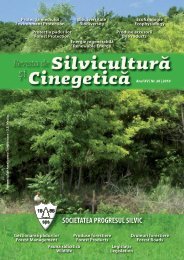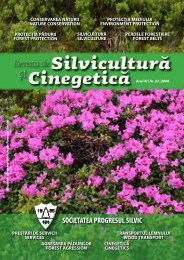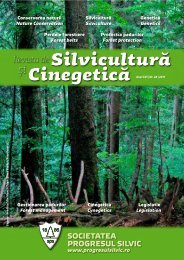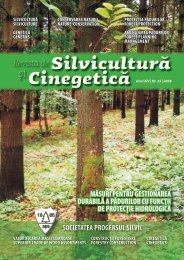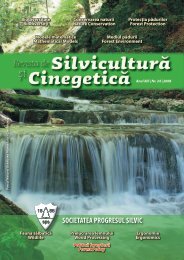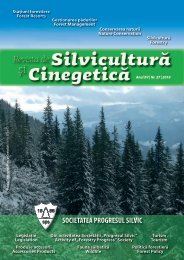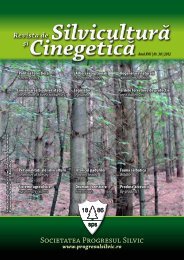Silviculture and Cinegetics Review - Societatea Progresul Silvic
Silviculture and Cinegetics Review - Societatea Progresul Silvic
Silviculture and Cinegetics Review - Societatea Progresul Silvic
Create successful ePaper yourself
Turn your PDF publications into a flip-book with our unique Google optimized e-Paper software.
FORESTRY BELTS SILVICULTURE AND CINEGETICS REVIEW XVII/30/2012<br />
The most effective <strong>and</strong> sustainable intimately mixed<br />
cultures are the ones that optimize space requirements<br />
<strong>and</strong> resources by avoiding competition between the<br />
two parts - trees <strong>and</strong> crops. It is necessary to consider<br />
the challenges involved in intimately mixed cultures:<br />
identification of installation difficulties <strong>and</strong> finding<br />
better ways to set up these agroforestry systems, using<br />
the most suitable compositions, namely the use of<br />
those agricultural species that are less competitive for<br />
forest cultures species than are weeds, knowledge of<br />
dynamics of plants in crop intimately mixed etc.<br />
Stationary conditions (soil <strong>and</strong> climate) may be<br />
limiting factors in achieving the intimate mixture of<br />
cultures. For example, in areas with depleted soil is<br />
not practiced this system, primarily because<br />
agricultural species contribute to a more pronounced<br />
depletion of the soil, then because forest species will<br />
be installed with difficulty in terms of competition<br />
with agricultural species.<br />
Forest species preferred for association with the<br />
agricultural ones this agroforestry system are usually<br />
the fast growing ones such as: hybrid poplars, black<br />
locust, Paulownia, but you can use also moderate<br />
growing species such as ash, walnut or even slow<br />
paced growing (oak species).<br />
Agricultural species used in this agroforestry system<br />
are: corn, sunflower, soybean, <strong>and</strong> medicinal herbs<br />
(lavender, mint, fennel etc.), species of vegetables etc.<br />
3.2. Intercropping<br />
Intercropping is another type of agroforestry<br />
system in which crops shall be installed <strong>and</strong> develop<br />
between the b<strong>and</strong>s (strips) of trees <strong>and</strong> / or shrubs<br />
(composed of one or two lines), situated at distances<br />
determined by the main production goals of the<br />
system (Fig. 3). The distance between the b<strong>and</strong>s varies<br />
therefore depending on the objectives <strong>and</strong> priorities<br />
established within the agroforestry system, being<br />
equal to the multiple of the width of machines used in<br />
maintenance <strong>and</strong> harvesting of crops (over 12 m<br />
distance). Distance between trees on the row ranges,<br />
at planting, from 0.75 m, if they have as their primary<br />
function protection against soil erosion, <strong>and</strong> 2 m, if it<br />
seeks production of wood or fruit.<br />
Fig. 3. Intercropping euramerican poplar - wheat.<br />
Experiment conducted in the European project SAFE<br />
(Sylvoarable Agroforestry for Europe). Vezenobres,<br />
France (Eichhorn et al., 2006)<br />
The purpose of achieving this system is to increase<br />
production of the main compound, which is the<br />
agricultural one, to diversify the overall production of<br />
the system (both long <strong>and</strong> short term) <strong>and</strong> to improve<br />
its quality.<br />
The presence of trees in agricultural crops contributes<br />
to soil stabilization, by stopping erosion <strong>and</strong> reducing<br />
l<strong>and</strong>slides helping soil water infiltration. Trees crowns<br />
protect crops against winds <strong>and</strong> reduce the effect of<br />
heavy rains. Moreover, the presence of trees aims to<br />
improve the circulation of nutrients, enhance<br />
diversity, <strong>and</strong> beautify l<strong>and</strong>scape.<br />
Under this agroforestry system crops coexist with<br />
trees simultaneously, the first providing annual<br />
production, while the trees grow, develop <strong>and</strong> mature<br />
in a longer period of time. Thus, it is diversified<br />
production on the same l<strong>and</strong> area <strong>and</strong> therefore<br />
income, which can come both from crops <strong>and</strong> from<br />
forestry. The presence of trees in the intercropping<br />
system may prevent any loss of production due to<br />
climatic excesses (heavy rain, strong winds etc.).<br />
Forest species used in intercropping are fruit trees,<br />
poplar, oak, ash, cherry, chestnut, pine, paulownia,<br />
walnut. To achieve a stable sustainable agroforestry<br />
system forest species must meet certain conditions, as<br />
follows: i) to be adapted to environmental <strong>and</strong> soil<br />
conditions where they are to be planted; ii) to be in<br />
relationships of low competitiveness with agricultural<br />
species; iii) to provide one or more high quality<br />
products (wood, bark, resin, leaves, flowers, fruit,<br />
tannins, etc..), <strong>and</strong> these products to be sold; iv) to be<br />
65



